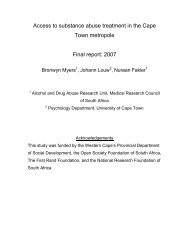Audit of Substance Abuse Treatment Facilities in ... - SA HealthInfo
Audit of Substance Abuse Treatment Facilities in ... - SA HealthInfo
Audit of Substance Abuse Treatment Facilities in ... - SA HealthInfo
- No tags were found...
Create successful ePaper yourself
Turn your PDF publications into a flip-book with our unique Google optimized e-Paper software.
1998b) and comprise only 31.0% <strong>of</strong> the client population at substance abuse treatmentfacilities. In contrast, White South Africans cont<strong>in</strong>ue to be over-represented <strong>in</strong> substanceabuse treatment facilities, relative to the demographic pr<strong>of</strong>ile <strong>of</strong> the general population.These f<strong>in</strong>d<strong>in</strong>gs are <strong>in</strong> keep<strong>in</strong>g with f<strong>in</strong>d<strong>in</strong>gs from previous audits <strong>of</strong> treatment facilities <strong>in</strong>Gauteng and KwaZulu-Natal (Myers & Fakier, 2007), Gauteng (Myers, 2004) and CapeTown (Myers & Parry, 2003).As substance abuse treatment need has not been properly <strong>in</strong>vestigated <strong>in</strong> South Africa, itis unclear whether there are disparities <strong>in</strong> the need for substance abuse treatment servicesamong the racially def<strong>in</strong>ed social groups. Despite this gap, emerg<strong>in</strong>g evidence suggeststhat poor Black/African communities may be especially vulnerable to substance usedisorders, due to the psychological stress associated with rapid urbanisation, poverty,neighbourhood social dysfunction, and a lack <strong>of</strong> basic <strong>in</strong>frastructure (Flisher & Charlton,2001; Kalichman et al., 2006; Latk<strong>in</strong>, Williams, Wang, & Curry, 2005) - factors that<strong>of</strong>ten characterise these communities. Anecdotal reports <strong>of</strong> <strong>in</strong>creas<strong>in</strong>g levels <strong>of</strong> substanceuse among Black/African communities also suggest that this pattern <strong>of</strong> service utilisationreflects the limited extent to which Black/African South Africans have access tosubstance abuse treatment rather than lower levels <strong>of</strong> substance use by these raciallydef<strong>in</strong>ed social groups (Myers et al., 2004; Myers & Parry, 2005).In terms <strong>of</strong> gender, f<strong>in</strong>d<strong>in</strong>gs show that women are also under-represented <strong>in</strong> substanceabuse treatment facilities. Although women comprise at least half <strong>of</strong> the generalpopulation (Statistics South Africa, 2005), on average less than 30.0% <strong>of</strong> the recipients <strong>of</strong>substance abuse treatment services <strong>in</strong> Free State, Limpopo, Mpumalanga, North West andNorthern Cape are women. This f<strong>in</strong>d<strong>in</strong>g is <strong>in</strong> keep<strong>in</strong>g with f<strong>in</strong>d<strong>in</strong>gs from previous audits<strong>of</strong> substance abuse treatment facilities <strong>in</strong> Cape Town; Gauteng as well as KwaZulu-Nataland Gauteng (Myers, 2004; Myers & Parry, 2003; Myers & Fakier, 2007) and<strong>in</strong>ternational research which po<strong>in</strong>ts to the under-representation <strong>of</strong> women <strong>in</strong> treatment(Schober & Annis, 1996; Zule, Lam, & Wechsberg, 2003). However, this pattern <strong>of</strong>treatment service utilisation by women probably reflects the limited extent to whichwomen have access to substance abuse treatment rather than lower levels <strong>of</strong> substanceuse by women; especially given research which suggests that similar proportions <strong>of</strong> menand women dr<strong>in</strong>k at risky levels <strong>in</strong> South Africa (Parry et al., 2005) and that po<strong>in</strong>ts to70
















